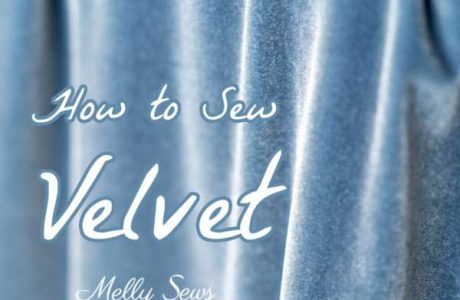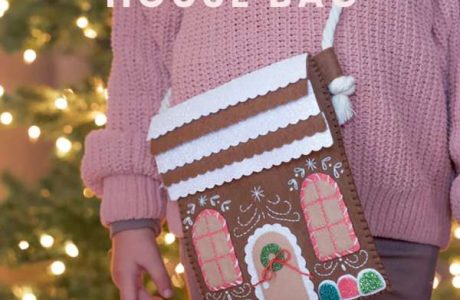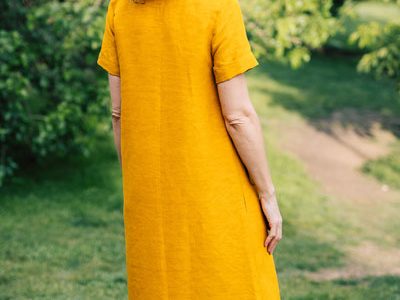 Today I’m super excited to present a Q & A session with Jenny Wilding Cardon, author of ReSew: Turn Thrift Store Finds Into Fabulous Designs
Today I’m super excited to present a Q & A session with Jenny Wilding Cardon, author of ReSew: Turn Thrift Store Finds Into Fabulous Designs. (Check out my review & giveaway for a chance to win a copy of the book.)
 The questions she answers are ones that were posted by Craft Gossip readers last week. I knew I was right to leave the questions to you – you came up with some good ones! Questions about fabric & project choice, how to sew for a range of figures, etc. Jenny took to the time to answer each and every one of them, so without further ado I’ll turn it over to her:
The questions she answers are ones that were posted by Craft Gossip readers last week. I knew I was right to leave the questions to you – you came up with some good ones! Questions about fabric & project choice, how to sew for a range of figures, etc. Jenny took to the time to answer each and every one of them, so without further ado I’ll turn it over to her:
Looking for more Wide leg pant patterns to sew? Check out these Wide Leg pant sewing patterns and Pdfs we found on Etsy.
Hi Anne, it’s me, Jenny!
DEE ASKS:
I thrift shop, but a lot of the clothes I find are smaller than my size. Will your book give ideas how to use smaller items and make them into great stuff for someone bigger? Example: I found the cutest shirt in retro 70?s wild fabric size large but its too small for me, my girl can cut it down to great stuff for her but I am at a lost how to use it for me.
Hi Dee! I’m glad you asked this question. I have a twofold answer. First, for the clothing projects in ReSew, you always start with something that fits YOU—there aren’t any patterns to trace and cut out to make something larger or smaller. The item you choose to work with should fit you from the get-go, that way it will fit you when it’s finished, no patterns needed. But I hear what you’re saying about having an item that is too small and still wanting to repurpose it because the fabric is cool. I have several skirts like that, and I repurpose shrunken wool sweaters to make accessories and other items all the time. I’m not sure what kind of fabric this cool-sounding retro shirt is (cotton, knit?) but there are a ton of ways to use the fabric and transform it into something else you’ll love—and something else that will fit! Here are two examples for what I did with shirts:
 If your retro shirt is knit (like t-shirt fabric), you can combine two shirts with coordinating colors and patterns to make a new top. This “Two-Tee Tank Top” is made from two short-sleeve knit shirts, and has an elastic casing around the chest. This starts as a summer top, but you could pair it with an open denim jacket or cardigan to show off the fabric you like and still stay warm during colder months!
If your retro shirt is knit (like t-shirt fabric), you can combine two shirts with coordinating colors and patterns to make a new top. This “Two-Tee Tank Top” is made from two short-sleeve knit shirts, and has an elastic casing around the chest. This starts as a summer top, but you could pair it with an open denim jacket or cardigan to show off the fabric you like and still stay warm during colder months!
.
.
 If your retro shirt is woven (meaning cotton, like a button-down shirt) you can also combine it with other pieces to create something new. This dress I call the “Diner Dress,” because I think it channels a ‘50s charm. It’s made from four different button-down shirts. They all coordinate in color, but one shirt (the top) is solid and the three shirts that create the skirt are patterned. You could choose a top that fits your shape for the shirt portion of the dress, and use your retro shirt in the skirt.
If your retro shirt is woven (meaning cotton, like a button-down shirt) you can also combine it with other pieces to create something new. This dress I call the “Diner Dress,” because I think it channels a ‘50s charm. It’s made from four different button-down shirts. They all coordinate in color, but one shirt (the top) is solid and the three shirts that create the skirt are patterned. You could choose a top that fits your shape for the shirt portion of the dress, and use your retro shirt in the skirt.
Whatever you choose, hold on to that cool shirt—whether it’s clothing, or accessories, or home accents, there are endless ways to give it a new life!
JENN ASKS:
How do you come up with the ideas for your projects? Also, what skill level do you need for your designs? Anything ideal for beginners?
Ideas come from the strangest places; I’ll take inspiration wherever I can get it. Most of the time, it’s the thrifted piece that will sort of yell at me. “I don’t want to be a sheet anymore! I want to be a fancy skirt. Make me into a fancy skirt!” And I’ll go from there. I also have a long piece of twine that is pinned in a zigzag shape on one wall in my sewing room. It’s there that I paper clip printed things that catch my eye—a page from a magazine, a picture of pretty purse, a postcard with a color combination I like. It’s nice to be able to have inspiration at the ready, especially at times when you feel like you can’t muster any.
As far as skill levels for ReSew, I would say that a confident beginner (i.e., someone who knows how to sew a straight line with a sewing machine) could make 14 out of the 20 projects in the book without difficulty. The other six require a bit more know-how, but the directions are clear, concise, and step-by-step. Some of the easiest projects from the book include:
 The “Sleeveless V.” Starting with a sweatshirt, this project uses straight-line sewing and machine applique. And beginners, please don’t be alarmed by a term like “machine applique!” It just means you are sewing one piece of fabric on top of another. Easy!
The “Sleeveless V.” Starting with a sweatshirt, this project uses straight-line sewing and machine applique. And beginners, please don’t be alarmed by a term like “machine applique!” It just means you are sewing one piece of fabric on top of another. Easy!
.
.
.
.
 This “Cuffed Skirt” is a more elegant project made from two pairs of men’s dress pants. Again, straight-line sewing. The gathered waist is made with a simple elastic casing.
This “Cuffed Skirt” is a more elegant project made from two pairs of men’s dress pants. Again, straight-line sewing. The gathered waist is made with a simple elastic casing.
.
.
.
.
.
.
This “Elephant Cuddle Cushion” could just be the easiest project in the book to make. It uses a just bit of machine sewing, along with a bit of hand sewing.
Repurposing really is a perfect place for beginning sewists to start; all of the most difficult parts of sewing have already been done for you! Starting with finished clothing items is a great way to introduce yourself to sewing basics. You’ll learn more about the next level as you notice the details of how a finished piece was put together. It’s like osmosis.
MELISSA ASKS:
I loved the sneak peak of your book. Your vision is really amazing. Do you try to use all elements of the former piece such as zippers and buttons? Also, does the fabric speak to you or do you normally have a project in mind before hitting the thrift store?
Good question! For ReSew, I purposefully tried to stay away from what beginners tend to find intimidating—mainly, as you mentioned, zippers and buttons! But yes, I definitely save those items. I have a mason jar full of buttons left over from thrifted shirts. I think it’s important to be organized about what you save; you can get into a big heap of a mess if there isn’t any structure to your saving. I typically don’t save small scraps from projects; it’s just too much stuff that I probably will never use. But I do have a basket brimming with the cuffs and collars of button-down shirts. I think they have potential—I’m just not sure what that potential is yet. I’m hoping it will come to me soon.
To answer your second question: yes! I go thrifting at least weekly. Sometimes I have a project in mind and I’m looking something specific to make it. Other times I just go and see what there is to see. I am still thinking about a brightly colored, striped queen-size comforter that I passed up last week at a local thrift store… should have snagged that one because I’ve had several ideas for how to use it since then. I guess it didn’t speak loud enough to me at the time!
JENN A-G ASKS:
Will your book have any tips for larger-sized women’s designs (A-line skirts, sleeved tops, etc.)? As it stands now, I can only imagine using your accessory patterns. But my imagination is awakened!
I’m glad this question came up, Jenn. The shirt, skirt, and the dress designs in ReSew all start with clothing that already fits you. Or they start with items that give you a lot of fabric to work with from the start, like sheets or curtains. All the shirts are sleeveless, but I can see how you could alter a few of designs a bit by keeping all or part of the sleeves from the original thrifted garment. For instance:
 This “Curtain Skirt” starts with two sheer curtains. Lots of flouncy fabric to work with.
This “Curtain Skirt” starts with two sheer curtains. Lots of flouncy fabric to work with.
.
.
.
.
.
.
This “Knit-Knot T-shirt” started with long sleeves. You could cut the sleeves to a short-sleeve length by using one of your favorite shirts as a template. In this case, if I was going to create short sleeves I would move the “knit-knots” in the design from the shoulders to the outer bottom edges of the sleeves. I think that would be cute!
This question makes me wish that I had included more sleeved designs in the book… but Jenn, you have inspired me with a challenge for the future! Thanks for that.
NANCY ASKS:
Do you have a preference for fabric type when you refashion something? Are knits easier than woven fabric? Organic (cotton, wool, linen, etc) better than synthetics or is the reverse true?
I’m not sure I have a preference for fabrics—I just take home whatever calls out to me and try to work with it. Knits are generally a little trickier to work with because they stretch. I’ve included some tips in ReSew for working with stretchier fabrics, particularly sweaters that aren’t felted wool (which doesn’t stretch at all). But really, I’ll give any fabric a try. Organic, synthetic, ‘70s, ‘80s, ‘90s, new-millenium—bring it on! I can’t say I’ve never had a failed project—I’ve had plenty of those!—but I love the opportunity to try working with something new.
JENNIFER D ASKS:
Love it!! Are your crafts easy enough for the self-taught novice like myself?
Well, aside from taking a sewing class with my mom on how to make Bermuda shorts back when I was a teenager, I am self-taught too! So to answer your question—absolutely. Starting with a finished project really does cut down on sewing difficulty. And when I was designing projects for ReSew, I kept beginners in mind. I really wanted the book as a whole to be usable at any sewing level. A few of the other beginner-friendly designs in the book include:
 This “Five-Square Purse,” which uses five cut-out squares from one sweater. Just a bit of simple machine sewing and a bit of hand sewing can get your comfortable with both techniques.
This “Five-Square Purse,” which uses five cut-out squares from one sweater. Just a bit of simple machine sewing and a bit of hand sewing can get your comfortable with both techniques.
.
.
.
.
.
 “Sweater Scarves!” These are really fun to make—I created one for women and one for men. You can make them as long, short, wide, or skinny as you want. Stick to the instructions, or make your squares larger or smaller to customize your project.
“Sweater Scarves!” These are really fun to make—I created one for women and one for men. You can make them as long, short, wide, or skinny as you want. Stick to the instructions, or make your squares larger or smaller to customize your project.
 This “Wraparound Shirt” is also really easy on the sewing difficulty scale. The diagonal stripes on the front are actually cut from the sleeves you remove from the sweatshirt. A glue stick is the key to making this project a cinch—to me, that’s just about as easy as it gets!
This “Wraparound Shirt” is also really easy on the sewing difficulty scale. The diagonal stripes on the front are actually cut from the sleeves you remove from the sweatshirt. A glue stick is the key to making this project a cinch—to me, that’s just about as easy as it gets!
For all of you who left them, thank you for your thoughtful questions! I have so enjoyed answering them; I hope I’ve encouraged you enough to give refashioning a try. It is a wacky, fun, delightful passion of mine, and I hope some of my enthusiasm for it will rub off on you. I truly believe handmade can change the world, one sweatshirt at a time. 🙂 Best to everyone who participated—now go and resew!
Anne, thank you so much for the opportunity to connect with your readers. CraftGossip is one of the best go-to places for handmade on the web, no doubt. I feel so lucky to have been able to visit and show CraftGossip readers my stuff!
If you’d like to contact me, you can reach me over at my blog, the wildcards. Good luck with the giveaway, everyone!
Thanks, Jenny, for taking the time to give your thoughts about this book and about refashioning! Check out my review & giveaway for a chance to win a copy of this book! –Anne







Leave a Reply